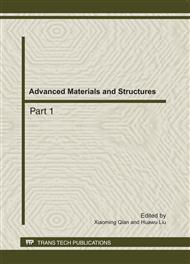p.478
p.483
p.487
p.491
p.498
p.502
p.506
p.511
p.515
Numerical Exploration of the Defect’s Effect on Mechanical Properties of Nanowires under Torsion
Abstract:
Molecular dynamics (MD) simulations have been carried out to investigate the defect’s effect on the mechanical properties of single-crystal copper nanowire with different surface defects, under torsion deformation. The torsional rigidity is found insensitive to the surface defects and the critical angle appears an obvious decrease due to the surface defects, the largest decrease is found for the nanowire with surface horizon defect. The deformation mechanism appears different degrees of influence due to surface defects. The surface defects play a role of dislocation sources. Comparing with single intrinsic stacking faults formation for the perfect nanowire, much affluent deformation processes have been activated because of surface defects, for instance, we find the twins formation for the nanowire with a surface 45o defect.
Info:
Periodical:
Pages:
498-501
Citation:
Online since:
September 2011
Authors:
Keywords:
Price:
Сopyright:
© 2011 Trans Tech Publications Ltd. All Rights Reserved
Share:
Citation:


